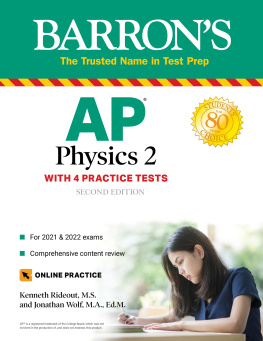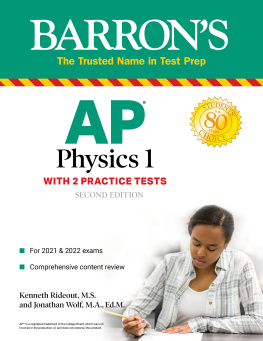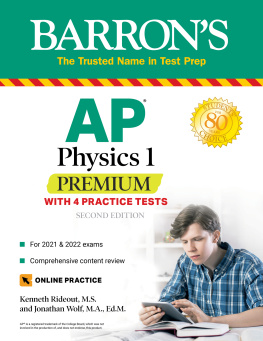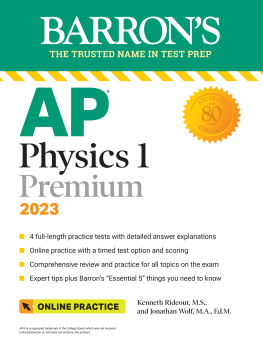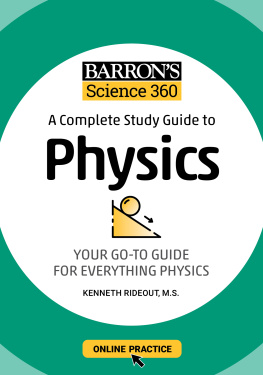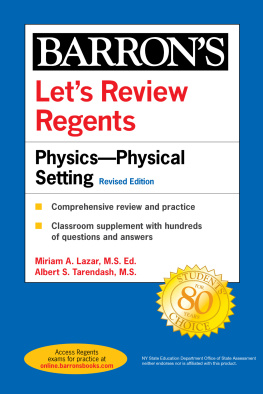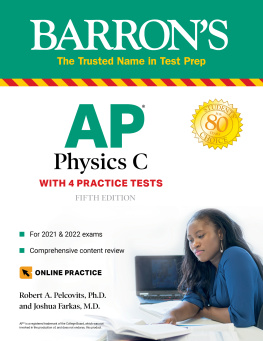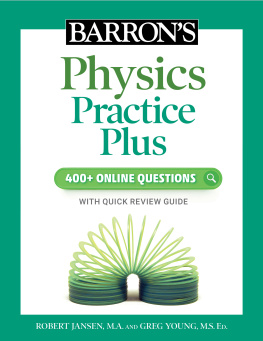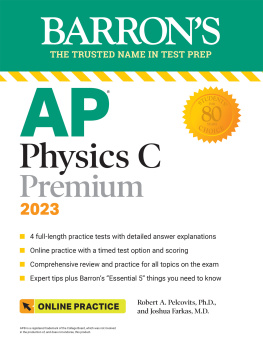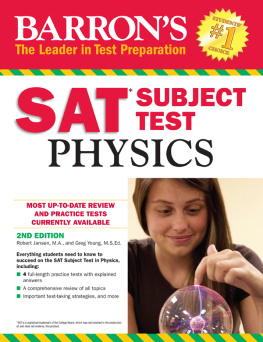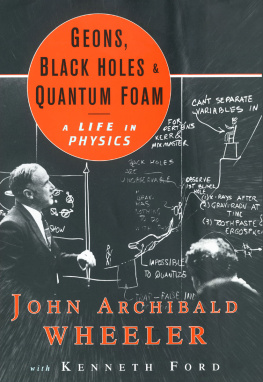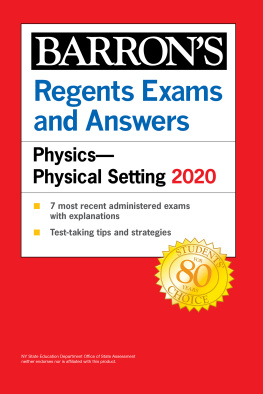Kenneth Rideout - Barrons AP Physics 2
Here you can read online Kenneth Rideout - Barrons AP Physics 2 full text of the book (entire story) in english for free. Download pdf and epub, get meaning, cover and reviews about this ebook. year: 2020, publisher: Barrons Educational Series, genre: Children. Description of the work, (preface) as well as reviews are available. Best literature library LitArk.com created for fans of good reading and offers a wide selection of genres:
Romance novel
Science fiction
Adventure
Detective
Science
History
Home and family
Prose
Art
Politics
Computer
Non-fiction
Religion
Business
Children
Humor
Choose a favorite category and find really read worthwhile books. Enjoy immersion in the world of imagination, feel the emotions of the characters or learn something new for yourself, make an fascinating discovery.
- Book:Barrons AP Physics 2
- Author:
- Publisher:Barrons Educational Series
- Genre:
- Year:2020
- Rating:4 / 5
- Favourites:Add to favourites
- Your mark:
- 80
- 1
- 2
- 3
- 4
- 5
Barrons AP Physics 2: summary, description and annotation
We offer to read an annotation, description, summary or preface (depends on what the author of the book "Barrons AP Physics 2" wrote himself). If you haven't found the necessary information about the book — write in the comments, we will try to find it.
Barrons AP Physics 2 — read online for free the complete book (whole text) full work
Below is the text of the book, divided by pages. System saving the place of the last page read, allows you to conveniently read the book "Barrons AP Physics 2" online for free, without having to search again every time where you left off. Put a bookmark, and you can go to the page where you finished reading at any time.
Font size:
Interval:
Bookmark:


About the Authors:
Ken Rideout has a B.S. in Honors Physics from Purdue University and an M.S. in Physics from Carnegie Mellon University. He has been teaching high school physics for more than fifteen years in the Boston area and is currently the science department head at Wayland High School in Wayland, Massachusetts.
Jonathan Wolf is an adjunct professor of physics at Fairleigh Dickinson University in Madison, New Jersey. He has been teaching physics at both the secondary school and college levels for more than thirty-five years. He has published over forty professional papers in the fields of astronomy, physics, and physics education and served for more than ten years as assistant editor for The Science Teachers Bulletin published by the Science Teachers Association of New York State (STANYS). In addition to being the author of Barrons AP Physics B, he is also the author of Barrons College Review: Physics and previously was co-author of Barrons SAT Subject Test in Physics.
Copyright 2021, 2018 by Kaplan, Inc., d/b/a Barrons Educational Series
All rights reserved under International and Pan-American Copyright Conventions. By payment of the required fees, you have been granted the non-exclusive, non-transferable right to access and read the text of this eBook on screen. No part of this text may be reproduced, transmitted, downloaded, decompiled, reverse engineered, or stored in or introduced into any information storage and retrieval system, in any form or by any means, whether electronic or mechanical, now known or hereinafter invented, without the express written permission of the publisher.
Published by Kaplan, Inc., d/b/a Barrons Educational Series
750 Third Avenue
New York, NY 10017
www.barronseduc.com
ISBN: 978-1-5062-7781-3
10 9 8 7 6 5 4 3 2 1
As you review the content in this book to work toward earning that on your AP Physics 2 exam, here are five things that you MUST know above everything else. | |
Review the key concepts of the AP Physics 1 curriculum (e.g., review the Essential 5 in Barrons AP Physics 1). AP Physics 2 is designed as a second-year course, and the key ideas of AP Physics 1 provide the essential knowledge base for the material for this exam. | |
Understand fields: Be able to visualize, draw, and interpret the major fields: gravitational, electric, and magnetic. Be able to make analogies between electric and gravitational fields. Understand the difference between the field strengths and the actual force exerted on an object in that field. Understand the differences between field potentials and the actual potential energy present when an object is in the field. | |
Know how and when to use the various models for light: Model light and all electromagnetic radiation as a wave for interactions such as diffraction and interference, and when describing it in terms of amplitude and wavelength. Model light as a series of wave-front rays for problems in optics (reflection, refraction, mirrors, and lenses). Model light as individual particles (photons) in atomic and modern physics. | |
Understand the limiting cases for capacitors in simple and complex circuits: Although detailed questions about the exponential nature of charging and discharging capacitors will not be asked, you must understand their behavior and purpose when fully charged or fully discharged in circuits. | |
Understand the energy conservation roots of thermodynamics and fluid dynamics: Understand the specialized vocabulary of thermodynamics and be able to connect all operations to energy transfers and transformations. Be able to go back and forth between the macroscopic descriptions of fluids and their microscopic behavior. |
In this review book, you will find all the material needed to review and prepare for the AP Physics 2 exam, a second-year precalculus course. This book is an updated, targeted, and enriched edition of an earlier edition of this book. This book (and the test itself) assumes you have familiarity with the material in the AP Physics 1 curriculum. AP Physics 2 should be seen not only as additional topics in physics but as a continuation of AP Physics 1 topics.
Each chapter has review questions that vary in style and level of difficulty. These are intended to test your level of understanding of the review material. Some of these chapter questions may be easier, harder, or of a slightly different style than the actual AP exam as they are limited to the content of that particular chapter. Likewise, each chapter has a mix of traditional problem-solving examples as well as the more text-based and conceptual questions that also appear on the AP Physics 2 exam. The tests, on the other hand, are broad in scope and draw from several different content areas at once. Included in this book, as well as online, are several full-length practice tests that mirror the actual AP exams in style, content, and difficulty. All questions have full solutions and explanations provided. Before the review chapters is a diagnostic exam that can be used for practice or to guide you specifically to certain content areas you may need to review before taking the test. Additional problem-solving strategies are provided throughout the book.
Most important, I want to thank my wife, Irene, for her support throughout this project.
Ken Rideout
Wayland, Massachusetts
May 2020
KEY CONCEPTS
STRUCTURE AND SCOPE OF THE AP PHYSICS EXAMS
The College Board currently offers four AP Physics exams. This book is for students preparing for the AP Physics 2 exam, which corresponds to a second-year algebra-based college course. The other exams are AP Physics 1 (a first-year algebra-based college course), AP Physics C Mechanics (calculus based), and AP Physics C Electricity and Magnetism (also calculus based). Note that the old AP Physics B is a retired test and is no longer offered by the College Board. Both the AP Physics 1 and AP Physics 2 exams focus on conceptual underpinnings and basic scientific reasoning along with the traditional problem-solving aspects of physics. In addition, both exams have questions that require experiential lab understanding. Although there are some calculation-oriented questions, these two tests are designed explicitly to not be plug and chug questions. If you do not thoroughly understand the physics concepts behind the equations, you will find yourself at a disadvantage.
TEST BASICS
90 minutes for fifty multiple-choice questions, including five multiple-correct questions (see )
90 minutes for four free-response questions
Calculator allowed throughout
Formula sheet and table of information provided throughout
The AP Physics 1 exam focuses on mechanics, the three conservation laws, electric charge and force, introductory circuits, and mechanical waves (including sound). The AP Physics 2 exam assumes you have already taken these topics and understand this material. If you have not studied these topics, it is highly recommended that you review these topics (with Barrons AP Physics 1, for example) before using this book. The AP Physics 2 exam not only assumes you have this background but covers overlapping topics such as force fields, circuits (now including capacitors), center of mass, and electromagnetic waves. Additional topics unique to the AP Physics 2 exam are thermodynamics, optics, fluids, modern physics, and magnetism.
Font size:
Interval:
Bookmark:
Similar books «Barrons AP Physics 2»
Look at similar books to Barrons AP Physics 2. We have selected literature similar in name and meaning in the hope of providing readers with more options to find new, interesting, not yet read works.
Discussion, reviews of the book Barrons AP Physics 2 and just readers' own opinions. Leave your comments, write what you think about the work, its meaning or the main characters. Specify what exactly you liked and what you didn't like, and why you think so.

